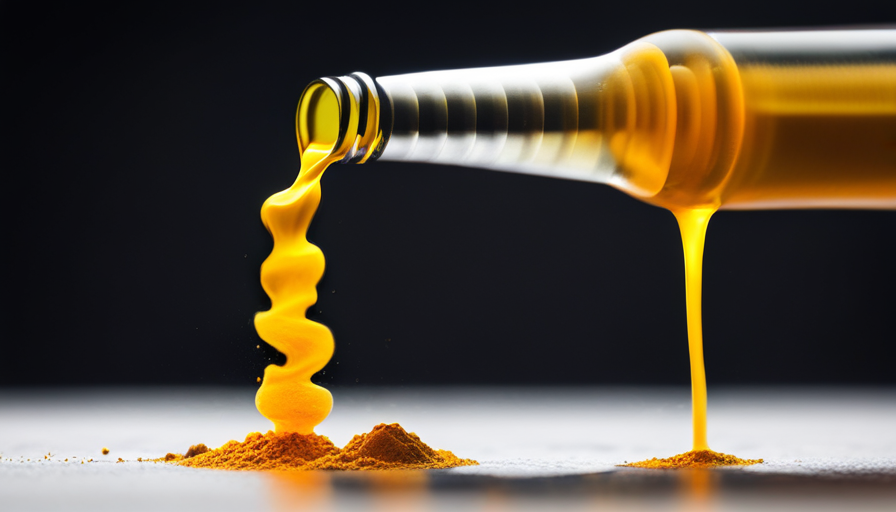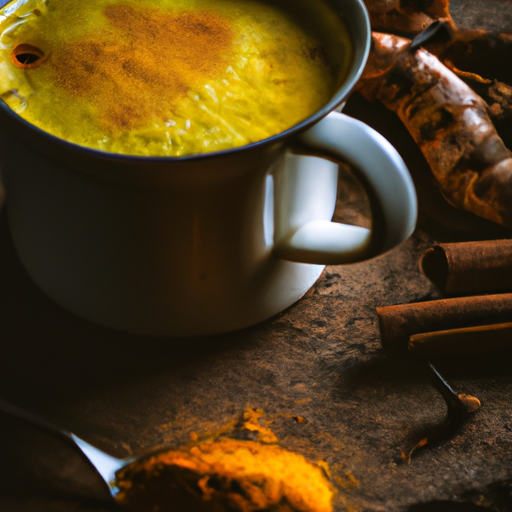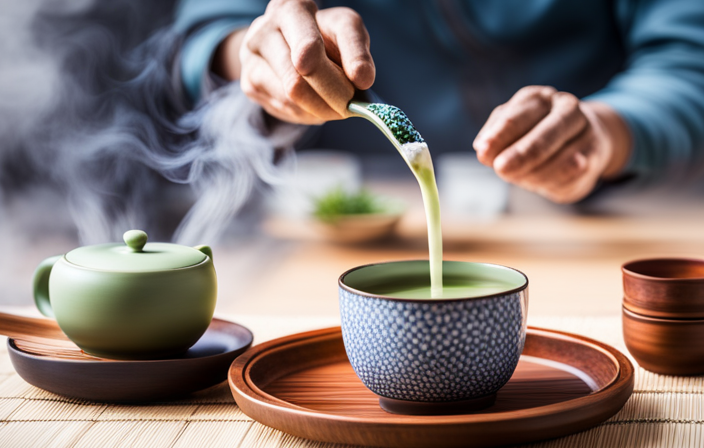Turmeric Tea
Does Turmeric Change Urine

A traditional saying suggests, ‘You are what you eat.’ What we eat can greatly affect our bodies, even influencing the color of our urine. Turmeric is one example of a food that has been linked to altering urine color.
Turmeric, a vibrant yellow spice commonly used in cooking and traditional medicine, contains a pigment called curcumin. This pigment is responsible for the characteristic golden hue of turmeric, and when consumed in large amounts, it can sometimes lead to a noticeable change in urine color.
But why does this happen? And is it something to be concerned about? In this article, we will delve into the science behind urine color, explore how turmeric affects urine color, discuss possible reasons for this change, and address any potential health concerns or benefits.
So, if you’ve ever wondered why your urine might look different after consuming turmeric, read on to uncover the truth behind this fascinating phenomenon.
Key Takeaways
- Turmeric’s pigment curcumin can cause a change in urine color, giving it a yellowish tinge.
- The liver metabolizes curcumin and excretes it through urine, resulting in the temporary urine color change.
- Changes in urine color due to turmeric consumption are harmless and temporary.
- Persistent or intense changes in urine color should be discussed with a healthcare professional.
The Science Behind Urine Color
Have you ever wondered why your urine color can vary so much from day to day? The color of urine can be influenced by several factors, including hydration levels and medication use.
When you are well-hydrated, your urine color tends to be a pale yellow or almost clear. This is because the kidneys are efficiently flushing out waste products, resulting in diluted urine. On the other hand, if you are dehydrated, your urine may appear more concentrated and have a darker yellow color.
Certain medications can also affect the color of your urine. For example, some antibiotics and laxatives can cause the urine to turn a bright yellow or even orange color. This is due to the presence of certain pigments in these medications that are excreted through the urine. Other medications, such as certain vitamins and minerals, can cause the urine to appear more vibrant or even fluorescent.
Now, let’s transition to the topic of turmeric’s pigment – curcumin.
Turmeric’s Pigment – Curcumin
Experience the vibrant transformation of your pee when you consume turmeric – ever wondered if it’s the secret behind that golden hue? Let’s dive into the science behind turmeric’s pigment, curcumin, and its effects on health.
Curcumin is the active compound in turmeric responsible for its distinctive yellow color. It is also known for its potent antioxidant and anti-inflammatory properties. To extract curcumin, various methods can be used, such as solvent extraction or steam distillation. Once consumed, curcumin is metabolized by the body and can be detected in urine.
Research suggests that curcumin may have several health benefits. Studies have shown its potential in reducing inflammation, improving brain function, and even preventing chronic diseases like cancer and heart disease. However, it’s important to note that most studies have been conducted in animal models or test tubes, and more research is needed to fully understand the effects of curcumin on human health.
As we explore the topic of turmeric and urine color further, it’s fascinating to consider how curcumin’s presence in the body may contribute to the changes we observe. Stay tuned for the next section, where we delve into the relationship between turmeric and urine color.
Turmeric and Urine Color
Witness the astonishing transformation in your body as the vibrant shades of gold emerge, leaving you in awe of the powerful effects of turmeric on the color of your pee. Turmeric has long been known for its potent pigment, curcumin, which is responsible for the distinctive yellow-orange hue. When consumed, curcumin is metabolized by the body and excreted through urine, resulting in a noticeable change in color.
To understand the impact of turmeric on urine color, let’s take a closer look at the science behind it. The liver plays a crucial role in metabolizing curcumin and converting it into water-soluble compounds. These compounds are then eliminated from the body through urine. As a result, the urine can acquire a yellowish tinge, sometimes even leaning towards a bright orange color.
It’s important to note that these urine color changes are harmless and temporary. They are merely a reflection of the body’s natural detoxification process. However, if you experience any other concerning symptoms alongside the color change, it’s advisable to consult a healthcare professional.
In the next section, we will explore possible reasons for urine color change, shedding light on any potential health effects.
Possible Reasons for Urine Color Change
Explore the various factors that can cause a shift in the color of your pee, allowing you to understand the potential reasons behind this intriguing phenomenon. When it comes to turmeric consumption, it’s known to have the ability to change urine color. The active compound in turmeric, called curcumin, is responsible for this effect. Curcumin can give urine a bright yellow or even orange color, which can be quite surprising for some individuals.
While a change in urine color due to turmeric consumption is generally harmless, it’s important to note that there can be other possible health implications related to urine color changes. For example, certain medical conditions like liver or kidney disease can also cause changes in urine color. This is why it’s crucial to pay attention to any drastic or persistent changes in urine color and seek medical advice if necessary.
In addition to turmeric, there are other natural remedies and foods that can also lead to changes in urine color. For instance, consuming beetroot can cause urine to turn pink or reddish. Similarly, consuming certain medications or supplements can also alter urine color.
Understanding the possible reasons behind urine color changes can help you identify any potential health concerns. In the next section, we’ll explore other factors that can affect urine color, providing you with a comprehensive understanding of this bodily function.
Other Factors that Can Affect Urine Color
Discover how various factors, such as hydration levels, certain medications, and even your diet, can influence the color of your pee. Medications and urine color can be related in some cases. Certain medications, like certain antibiotics or laxatives, can cause changes in urine color. For example, some antibiotics can turn urine a bright yellow or even orange color. Additionally, medications that contain dyes or pigments, such as some antipsychotic drugs, can also affect urine color.
Another factor that can impact urine color is dehydration. When you’re dehydrated, your body doesn’t have enough water to flush out waste products, which can lead to concentrated urine. This concentrated urine can appear darker in color, often a deep yellow or amber.
It’s important to note that changes in urine color due to medications or dehydration are usually harmless and temporary. However, if you notice persistent changes in urine color or experience other symptoms, it’s always best to consult with a healthcare professional.
Understanding how medications and dehydration can affect urine color is just the beginning. In the next section, we’ll explore the potential health concerns or benefits associated with changes in urine color.
Potential Health Concerns or Benefits
Experiencing shifts in urine color can serve as a valuable indicator of potential health issues or advantageous wellness outcomes. When it comes to turmeric consumption, it’s important to consider the potential side effects and benefits it may have on urine color.
Scientific research suggests that turmeric can cause a temporary change in urine color, turning it into a bright yellow or even orange hue. This is due to a compound called curcumin, which is responsible for turmeric’s vibrant color.
To further understand the implications of this color change, it’s crucial to consult scientific studies. One study published in the Journal of Medicinal Food found that consuming turmeric extract caused a significant increase in urinary excretion of curcumin metabolites. Another study conducted by the Department of Physiology at the University of California, Davis, discovered that the yellow pigment in turmeric, known as urothione, could be detected in the urine after ingestion.
However, it’s important to note that while turmeric may cause a temporary change in urine color, it’s generally considered safe for consumption. If you notice a sudden and persistent change in urine color after consuming turmeric or any other substance, it’s advisable to consult a healthcare professional to rule out any potential health concerns.
Transitioning into the subsequent section about managing urine color change, it’s important to be aware of tips for maintaining optimal urine color.
Tips for Managing Urine Color Change
To manage any shifts in the color of your urine, try implementing these tips for maintaining optimal urinary health.
First and foremost, managing hydration is key. Make sure to drink enough water throughout the day to keep your urine diluted and flowing smoothly. This can help prevent concentration of any pigments that may be causing the color change.
Additionally, certain dietary adjustments can also be helpful. Avoid foods and drinks that are known to cause urine discoloration, such as beets or certain medications. Incorporate foods and drinks that promote urinary health, like cranberry juice or green tea.
It’s important to note that if you’re experiencing persistent or concerning changes in urine color, it’s best to consult with a healthcare professional for further evaluation.
With these tips in mind, you can manage any shifts in urine color while taking turmeric. If you’re looking to explore other ways to incorporate turmeric into your wellness routine, continue reading the next section.
Other Ways to Incorporate Turmeric
If you’re looking for alternative ways to incorporate turmeric into your routine, there are plenty of options to explore. Besides adding turmeric to your meals, there are various turmeric recipes and turmeric supplements available that can help you reap the benefits of this vibrant spice.
One way to incorporate turmeric into your diet is by trying out different turmeric recipes. You can find a wide range of recipes online that feature turmeric as a key ingredient. From golden milk to turmeric-spiced roasted vegetables, there are endless possibilities to experiment with. These recipes not only add flavor to your meals but also provide you with the potential health benefits of turmeric.
Another option is to incorporate turmeric into your routine through turmeric supplements. These supplements are available in various forms, including capsules, powders, and liquids. They offer a convenient way to consume turmeric and ensure you’re getting a consistent dosage of its active compound, curcumin.
By exploring turmeric recipes and incorporating turmeric supplements into your routine, you can easily incorporate this beneficial spice into your daily life. These options provide you with flexibility and convenience in reaping the potential health benefits of turmeric. As we move into the next section about personal experiences and testimonials, you’ll discover how others have incorporated turmeric into their lives.
Personal Experiences and Testimonials
In my personal experience, I’ve heard stories from individuals who’ve experienced urine color change as a result of consuming turmeric. Some have reported a vibrant yellow color, while others have noted a more orange or even reddish hue.
Additionally, reactions and experiences can vary greatly from person to person, with some individuals reporting no change in urine color at all. These personal testimonials highlight the individualized nature of how turmeric may affect urine color and serve as evidence of the varied reactions and experiences that can occur.
Stories from Individuals who have Experienced Urine Color Change
Imagine waking up one morning and noticing that your urine has transformed into a vibrant shade of yellow after consuming turmeric the previous day. It can be a surprising and even alarming experience for some individuals. I have come across several stories from people who have experienced this urine color change after consuming turmeric. While it may seem strange, it is actually a well-known and documented effect of the spice. Turmeric contains a compound called curcumin, which is responsible for its yellow color. When consumed in large amounts, curcumin can be excreted through urine, resulting in the change in color. This phenomenon is harmless and temporary, usually lasting only a day or two. It is important to note that urine color changes alone are not indicative of any specific health effects. Transitioning into the subsequent section about ‘varied reactions and experiences,’ individuals have reported a wide range of responses to turmeric consumption.
Varied Reactions and Experiences
Get ready to embark on a rollercoaster of experiences as you delve into the diverse reactions people have encountered while consuming turmeric – it’s a wild ride you won’t want to miss! Here are three varied reactions and experiences individuals have reported:
-
Mild Color Change: Some people have noticed a slight yellowish tinge in their urine after consuming turmeric. This is generally considered harmless and temporary.
-
No Color Change: Interestingly, there are individuals who have consumed turmeric regularly but haven’t experienced any noticeable change in their urine color. This suggests that the reaction can vary from person to person.
-
Health Concerns: While most color changes are harmless, it’s important to note that intense or persistent changes in urine color should be discussed with a healthcare professional. In some cases, it could indicate an underlying health issue that needs attention.
Overall, the reactions to turmeric’s impact on urine color can vary greatly from person to person. It’s always advisable to consult a healthcare professional if you have any concerns about your health.
Frequently Asked Questions
Can turmeric change the color of urine to a different color than yellow?
Turmeric can indeed change the color of urine, but it typically turns it a more vibrant shade of yellow. However, it is unlikely to change the color to a completely different shade.
As for urine odor, turmeric may cause a subtle change in smell due to its natural compounds. Additionally, turmeric has been found to slightly alter urine pH levels, but this change isn’t significant enough to cause any health concerns.
Is it normal for urine color to change after consuming turmeric?
It’s normal for urine color to change after consuming turmeric. Turmeric contains a compound called curcumin, which can give urine a bright yellow color. However, it’s important to note that the change in urine color is temporary and harmless. It’s also essential to stay hydrated when consuming turmeric, as adequate hydration supports kidney health. Overall, turmeric can affect urine color, but it doesn’t indicate any health concerns.
How long does it take for turmeric to affect urine color?
When it comes to the effect of turmeric on urine color, it varies from person to person. However, in general, it takes a few hours for turmeric to start affecting the color of urine. The active compound in turmeric, curcumin, can give urine a yellowish tint.
It’s important to note that staying hydrated can help dilute the color, and turmeric has been shown to have potential benefits for kidney health.
Are there any health risks associated with turmeric causing urine color change?
There are potential health benefits associated with turmeric, but it’s important to note that turmeric causing urine color change is generally harmless. The recommended dosage of turmeric varies depending on the form it’s taken in, such as capsules or powder. It’s always a good idea to consult with a healthcare professional before starting any new supplement.
Overall, while turmeric may change urine color, there are typically no significant health risks associated with this phenomenon.
Can turmeric supplements cause more significant changes in urine color compared to turmeric used in cooking?
Turmeric supplements can cause more noticeable changes in urine color compared to turmeric used in cooking. While both forms of turmeric can cause urine to turn bright yellow or orange, supplements tend to produce a more intense color change. This is because turmeric supplements contain higher concentrations of curcumin, the active compound responsible for the color change.
It’s important to note that the frequency of urine color change may vary depending on individual factors such as dosage and metabolism.
Conclusion
In conclusion, after examining the science behind urine color and the effects of turmeric on it, it’s clear that turmeric can indeed change the color of urine. This is mainly due to the presence of curcumin, the pigment in turmeric.
While urine color change is generally harmless and temporary, it’s important to monitor any sudden or persistent changes, as they may indicate underlying health concerns.
Overall, incorporating turmeric into your diet can have potential health benefits, but it’s always best to consult with a healthcare professional for personalized advice.
As the saying goes, "A little turmeric can add a splash of color to your life." But too much can stain everything yellow!
Turmeric Tea
What Happens To Your Body When You Drink Turmeric

Hello, fellow health enthusiasts! As the saying goes, ‘An apple a day keeps the doctor away.’ But what if I told you there’s another potent remedy that can greatly benefit your body?
Yep, I’m talking about turmeric, that vibrant yellow spice that adds a burst of flavor to your favorite dishes. But did you know that drinking turmeric can actually have some amazing benefits for your overall well-being?
When you take a sip of turmeric goodness, you’re not only tantalizing your taste buds, but you’re also giving your immune system a much-needed boost. This golden spice contains a compound called curcumin, which has been shown to have powerful antioxidant and anti-inflammatory properties. That means it can help reduce inflammation in the body, improve digestion, and even support brain health.
But that’s not all! Turmeric is also a secret weapon for enhancing your skin health, aiding in weight management, and fighting against chronic diseases. So, whether you’re looking to improve your immune system, soothe inflammation, or just give your overall health a little pick-me-up, turmeric might just be the magical elixir you’ve been searching for.
Cheers to good health!
Key Takeaways
- Drinking turmeric boosts the immune system and stimulates immune cell activity.
- Turmeric reduces inflammation in the body and improves digestion.
- Turmeric aids in weight management by promoting fat burning and reducing inflammation.
- Turmeric supports brain health by reducing inflammation, boosting antioxidant activity, and enhancing neuroplasticity.
Boosts Immune System
Drinking turmeric boosts your immune system, helping to create a shield of protection around your body. Turmeric contains a compound called curcumin, which has been shown to enhance immune function. It stimulates the activity of immune cells, such as T cells, B cells, and natural killer cells, which play a crucial role in fighting off infections and diseases. Studies have also found that curcumin increases the production of certain proteins that regulate immune responses.
By incorporating turmeric into your diet, you can strengthen your immune system and improve your body’s ability to defend against harmful pathogens. Furthermore, turmeric is a natural remedy that’s been used for centuries to promote overall health and wellness. It’s a powerful antioxidant and anti-inflammatory agent, which further supports immune function.
With its numerous benefits, turmeric is a valuable addition to any health-conscious individual’s routine. As we transition to the next section about reducing inflammation, it’s important to note that turmeric’s ability to boost the immune system also contributes to its anti-inflammatory properties.
Reduces Inflammation
Experience the amazing benefits of turmeric as it actively works to reduce inflammation within you. Turmeric contains a compound called curcumin, which has powerful anti-inflammatory properties. By reducing inflammation, turmeric can help alleviate joint pain and ease muscle soreness. But how exactly does turmeric achieve this? Let’s take a closer look at the science behind it.
Studies have shown that curcumin can block certain molecules that play a role in inflammation, such as TNF-alpha and NF-kappaB. This can help reduce the production of inflammatory chemicals in the body, leading to a decrease in inflammation and its associated symptoms. Turmeric’s anti-inflammatory effects have been compared to those of non-steroidal anti-inflammatory drugs (NSAIDs), but without the potential side effects.
Reducing inflammation is just one way turmeric can benefit your body. It also improves digestion by stimulating the production of bile, which aids in the breakdown of fats. So not only can turmeric help reduce inflammation, but it also supports a healthy digestive system.
Improves Digestion
Turmeric’s ability to improve digestion can be visualized as it stimulates the production of bile, aiding in the breakdown of fats. This golden spice has been shown to improve gut health by reducing inflammation in the digestive system and promoting the growth of beneficial gut bacteria. It has also been found to relieve bloating and indigestion by increasing the secretion of digestive enzymes.
Furthermore, turmeric’s active compound, curcumin, has been found to have protective effects on the stomach lining, preventing ulcers and reducing the risk of gastrointestinal disorders. These benefits make turmeric a valuable addition to any diet for those looking to improve their digestive health.
Moving forward, let’s explore how turmeric supports brain health and cognitive function.
Supports Brain Health
To truly enhance your cognitive abilities and protect your brain health, it’s crucial to understand how turmeric can play a pivotal role in supporting these important aspects of your overall well-being. Turmeric has been found to have numerous benefits for brain function and cognitive function. Here are three key ways that turmeric supports brain health:
-
Reduces inflammation: Turmeric contains a compound called curcumin, which has powerful anti-inflammatory properties. Inflammation in the brain has been linked to cognitive decline and neurodegenerative diseases like Alzheimer’s. Turmeric can help reduce inflammation and protect brain cells from damage.
-
Boosts antioxidant activity: Oxidative stress can lead to brain aging and cognitive decline. Turmeric acts as a potent antioxidant, neutralizing harmful free radicals and protecting the brain from oxidative damage.
-
Enhances neuroplasticity: Neuroplasticity refers to the brain’s ability to adapt and form new connections. Studies have shown that curcumin in turmeric can enhance neuroplasticity, promoting learning, memory, and overall cognitive function.
Understanding how turmeric supports brain health is just the first step towards improving your overall well-being.
Next, we’ll explore how turmeric enhances skin health.
Enhances Skin Health
Imagine a world where your skin is as smooth and glowing as a radiant sunrise, and turmeric is the magical elixir that unlocks this beauty secret. Turmeric, the golden spice often found in curries, has been used for centuries in traditional medicine for its numerous health benefits. When it comes to skin health, turmeric has emerged as a powerful ingredient.
Its anti-inflammatory properties make it an effective treatment for acne, reducing redness and irritation. Additionally, turmeric’s antioxidant properties help fight off free radicals that contribute to premature aging, making it a natural anti-aging remedy. Incorporating turmeric into your skincare routine can enhance your skin’s health and give you a youthful, radiant glow.
Now, let’s explore how turmeric aids in weight management.
Aids in Weight Management
If you’re looking to shed a few pounds, incorporating turmeric into your diet can be a helpful aid in managing your weight. Turmeric has been found to have weight loss benefits due to its ability to boost metabolism.
Here are three ways turmeric can support your weight management journey:
-
Increased fat burning: Turmeric contains a compound called curcumin, which has been shown to promote the breakdown of fats and prevent the formation of new fat cells in the body.
-
Reduced inflammation: Chronic inflammation in the body can hinder weight loss efforts. Turmeric has potent anti-inflammatory properties that can help reduce inflammation and promote weight loss.
-
Improved digestion: Turmeric stimulates the production of bile, which aids in the digestion of fats. This can improve your body’s ability to break down and absorb nutrients, leading to better weight management.
Incorporating turmeric into your daily routine can have numerous benefits, including aiding in weight management.
Moving on to the next section, turmeric also fights against chronic diseases.
Fights Against Chronic Diseases
You’ll be amazed at how turmeric fights against chronic diseases and improves your overall health. One of the key benefits of turmeric is its ability to reduce pain and inflammation in the body. Curcumin, the active compound in turmeric, has been shown to have powerful anti-inflammatory properties. This can help alleviate symptoms of chronic diseases such as arthritis and osteoarthritis.
Additionally, turmeric has been found to prevent heart disease by reducing the risk factors associated with it. Studies have shown that curcumin can help lower cholesterol levels, reduce blood pressure, and improve blood vessel function. By incorporating turmeric into your daily routine, you can reap these benefits and protect yourself against chronic diseases while improving your overall well-being.
Frequently Asked Questions
Can turmeric help with managing symptoms of autoimmune diseases?
Yes, turmeric can help manage symptoms of autoimmune diseases. It acts as a natural remedy for inflammation, reducing pain and swelling. It also supports the immune system, helping to regulate immune responses and alleviate symptoms.
Does turmeric have any potential side effects or interactions with medication?
Turmeric has potential drug interactions, especially with blood thinners. It can enhance the effects of these medications, increasing the risk of bleeding. It is important to consult with a healthcare professional before using turmeric alongside any medications.
How much turmeric should be consumed daily to experience its health benefits?
To experience the health benefits of turmeric, it is recommended to consume 1-3 grams of turmeric per day. This dosage has been shown to have anti-inflammatory, antioxidant, and potential anticancer effects.
Is turmeric safe to consume during pregnancy or while breastfeeding?
Yes, turmeric is generally safe to consume during pregnancy or while breastfeeding. It can help with morning sickness and postpartum recovery. However, it’s always best to consult with your healthcare provider before adding any new supplement to your diet.
Are there any specific precautions or guidelines to follow when using turmeric as a dietary supplement?
When using turmeric as a dietary supplement, it’s important to follow precautions. One interesting statistic is that the recommended dosage for turmeric supplementation is typically 500-2,000 mg per day for adults.
Conclusion
In conclusion, after investigating the effects of drinking turmeric on the body, it’s evident that this powerful spice offers numerous health benefits. Not only does it boost the immune system and reduce inflammation, but it also improves digestion and supports brain health. Additionally, it enhances skin health and aids in weight management. It also fights against chronic diseases. With all these evidence-based benefits, incorporating turmeric into your diet can be a practical and effective way to improve your overall well-being.
Turmeric Tea
Can I Take Turmeric Tea Before Bed Time

Picture this: After a busy and tiring day, you’re looking forward to relaxing and getting ready to sleep. As you get ready for bed, you decide to have a soothing cup of turmeric tea. The question comes to mind: Is it safe to drink turmeric tea before going to sleep?
In this article, we will explore the potential benefits and drawbacks of consuming turmeric tea before bed.
Turmeric, a vibrant yellow spice commonly found in curry dishes, has gained popularity for its potential health benefits. From its potent anti-inflammatory properties to its antioxidant effects, turmeric has been praised for its ability to support overall well-being. But what about its impact on sleep quality?
Some studies suggest that turmeric may play a role in promoting relaxation and improving sleep. Its active compound, curcumin, has been shown to have calming effects on the body and mind. Additionally, turmeric tea is often enjoyed with other soothing ingredients like ginger and cinnamon, further enhancing its potential to induce relaxation.
However, it’s important to consider potential drawbacks as well. Turmeric can stimulate digestion and increase bile production, which may cause discomfort if consumed too close to bedtime. Additionally, some individuals may experience allergic reactions or interactions with medications.
Incorporating turmeric tea into your evening routine can be a delightful and healthful practice, but it’s essential to listen to your body and pay attention to any adverse effects. In the following sections, we will delve deeper into the potential benefits, drawbacks, and tips for incorporating turmeric tea into your bedtime routine.
So, let’s explore whether turmeric tea before bed is right for you.
Key Takeaways
- Turmeric tea can potentially improve sleep quality due to its calming effects on the body and mind.
- Consuming turmeric tea before bedtime may cause discomfort if it stimulates digestion too close to bedtime.
- Some individuals may experience allergic reactions or interactions with medications when consuming turmeric.
- Turmeric tea can have a positive impact on sleep by reducing inflammation, promoting relaxation, and enhancing the production of melatonin.
The Potential Health Benefits of Turmeric Tea
If you’re looking for a delicious and relaxing way to wind down before bed, turmeric tea has the potential to provide you with a plethora of health benefits. Turmeric is a spice that’s been used for centuries in traditional medicine for its anti-inflammatory properties. Research suggests that curcumin, the main active compound in turmeric, can help reduce inflammation in the body. This can be particularly beneficial for those with chronic conditions such as arthritis or inflammatory bowel disease.
Additionally, turmeric has been shown to improve digestion by increasing the production of bile, which helps break down fats and aids in the absorption of nutrients. These effects of turmeric on inflammation and digestion can contribute to better overall health and well-being.
Moving on to the impact of turmeric on sleep quality, it’s important to note…
The Impact of Turmeric on Sleep Quality
Consuming turmeric before retiring for the night can potentially influence the quality of one’s sleep. Research suggests that turmeric may have a positive impact on sleep, particularly in relation to insomnia and REM sleep.
Turmeric contains a compound called curcumin, which has been found to possess various health benefits, including its potential role in improving sleep. Studies have shown that curcumin can help reduce inflammation and oxidative stress in the body, both of which can contribute to sleep disturbances. Additionally, curcumin may also enhance the production of melatonin, a hormone that regulates sleep-wake cycles.
While more research is needed to fully understand the effects of turmeric on sleep quality, incorporating turmeric into your bedtime routine may be worth considering.
In the subsequent section, we will explore the role of turmeric in promoting relaxation and its potential impact on stress levels.
The Role of Turmeric in Promoting Relaxation
Unwind and relax with the soothing effects of turmeric, as it helps you achieve a peaceful state of mind. Turmeric has been known for its role in relieving inflammation and joint pain, but it also plays a significant role in promoting relaxation.
Here are three ways turmeric can help you unwind before bed:
-
Reducing inflammation: Turmeric contains a compound called curcumin, which has powerful anti-inflammatory properties. By reducing inflammation in the body, turmeric can help alleviate discomfort and promote a more relaxed state.
-
Improving digestion: Turmeric has been shown to enhance digestion and support gut health. A healthy gut is essential for a good night’s sleep, as it helps regulate the production of neurotransmitters that promote relaxation.
-
Calming the mind: Turmeric has been used in traditional medicine for its calming properties. It can help reduce anxiety and stress, allowing you to achieve a more peaceful state of mind before bed.
While turmeric can have many benefits, it’s important to consider potential drawbacks of consuming it before bed.
Potential Drawbacks of Consuming Turmeric Before Bed
Although there are potential drawbacks, it’s crucial to be aware of the side effects of incorporating turmeric into your evening routine. While turmeric is generally safe for consumption, some individuals may experience certain side effects when consuming it before bed. These potential side effects include gastrointestinal issues such as stomach upset, bloating, and acid reflux. It’s important to note that these side effects are not experienced by everyone and may vary from person to person. To emphasize the importance of being aware of these potential side effects, consider the following table:
| Potential Side Effects of Turmeric Before Bed |
|---|
| Stomach Upset |
| Bloating |
| Acid Reflux |
If you find that turmeric tea before bed doesn’t suit you, there are alternative bedtime beverages you can try, such as chamomile or lavender tea. These herbal teas also promote relaxation and can be a good substitute. Moving on to tips for incorporating turmeric tea into your evening routine…
Tips for Incorporating Turmeric Tea into Your Evening Routine
To seamlessly incorporate turmeric tea into your evening routine, try adding a warm, soothing cup of this golden elixir to your nightly wind-down ritual. Turmeric has been shown to have positive effects on digestion, making it a great choice before bed. It can help reduce bloating and improve overall gut health, promoting a more restful sleep.
When’s the best time to drink turmeric tea? Ideally, you should consume it about an hour before bedtime to allow your body to fully absorb its beneficial properties.
As for the preparation, here are a few tips:
- Use high-quality turmeric powder or fresh turmeric root for maximum potency.
- Add a pinch of black pepper to enhance turmeric’s absorption.
- Steep the tea for at least 10 minutes to extract all the goodness.
By incorporating turmeric tea into your bedtime routine, you can reap its digestion benefits and enjoy a more peaceful sleep.
Now, let’s explore other factors that can affect sleep quality.
Other Factors That Can Affect Sleep Quality
Did you know that your sleep quality can be influenced by factors such as room temperature, noise levels, and even the color of your bedroom walls? It’s important to consider these factors when trying to improve your sleep.
Another factor that can affect sleep quality is exercise. Regular physical activity has been shown to improve sleep, helping you fall asleep faster and stay asleep longer. However, it’s important to avoid exercising too close to bedtime, as it can increase alertness and make it harder to fall asleep.
Additionally, the effects of caffeine on sleep quality are well-known. Consuming caffeine, such as in coffee or tea, can interfere with your ability to fall asleep and stay asleep. Therefore, it’s best to avoid consuming caffeine in the evening if you want to have a good night’s sleep.
Transitioning into the subsequent section, it’s important to consider these factors when deciding if turmeric tea before bed is right for you.
Conclusion: Is Turmeric Tea Before Bed Right for You?
Consider the potential benefits of incorporating turmeric tea into your nighttime routine, as it may have a positive impact on your overall sleep quality. Turmeric tea has been associated with various health benefits, including improved digestion and potential weight loss effects. While more research is needed to fully understand the mechanisms behind these benefits, turmeric contains compounds called curcuminoids that possess anti-inflammatory and antioxidant properties. These properties may help support a healthy digestive system, which can in turn promote better sleep. Additionally, some studies suggest that curcumin, the main active compound in turmeric, may aid in weight loss by reducing inflammation and improving metabolism. However, it is important to note that turmeric tea alone is not a magic solution for weight loss and should be combined with a balanced diet and regular exercise. Overall, incorporating turmeric tea into your nighttime routine may have potential benefits for sleep quality, digestion, and weight management.
Frequently Asked Questions
What is the recommended dosage of turmeric tea before bed?
The recommended dosage of turmeric tea before bed varies, but generally, 1-2 cups is sufficient. The benefits of turmeric tea before bed include its anti-inflammatory properties, aiding digestion, and promoting relaxation for a good night’s sleep.
Can turmeric tea interfere with certain medications?
Turmeric tea may interact with blood thinners, potentially increasing the risk of bleeding. As a sleep aid, turmeric tea has limited scientific evidence. It’s important to consult with a healthcare professional before using turmeric tea, especially if taking blood thinners.
Are there any specific brands or types of turmeric tea that are better for sleep?
There are no specific brands or types of turmeric tea that are known to be better for sleep. However, turmeric tea benefits overall health and can be made using various recipes to suit individual preferences.
Can turmeric tea help with sleep disorders such as insomnia?
Turmeric tea benefits sleep disorders like insomnia. Its active compound, curcumin, helps regulate sleep-wake cycles. A simple turmeric tea recipe involves boiling water, adding turmeric powder, and steeping for 10 minutes before straining.
Can turmeric tea cause any negative side effects if consumed before bed?
Consuming turmeric tea before bed may have negative side effects on sleep quality. Studies suggest that turmeric tea can disrupt sleep patterns and cause insomnia.
Conclusion
In conclusion, you can take turmeric tea before bed. It can be a beneficial addition to your evening routine. The potential health benefits, such as reducing inflammation and improving digestion, make it a great choice for overall wellness. Additionally, turmeric’s impact on sleep quality and its role in promoting relaxation further support its use before bedtime. However, it’s important to note that individual responses may vary, and some individuals may experience digestive discomfort. To incorporate turmeric tea effectively into your routine, start with small amounts and monitor how your body responds. Sweet dreams and soothing sips await!
Turmeric Tea
Can You Freeze Keema

I recently found myself with an abundance of tasty homemade keema, and I pondered if it was feasible to freeze it for future enjoyment. After conducting some research and trying it out, I learned that freezing keema is actually doable, and it offers a convenient option to have this delicious dish ready whenever you crave it.
Keema is a popular South Asian dish made with minced or ground meat, typically lamb or beef, cooked with a blend of aromatic spices, onions, garlic, and ginger. It is incredibly versatile and can be used in various recipes, such as keema samosas, keema curry, or keema stuffed parathas.
To properly freeze keema, it’s important to ensure that it is cooked thoroughly and cooled down before packaging it in airtight containers or freezer bags. Alternatively, you can also freeze raw keema, but it’s essential to follow proper food safety guidelines.
In this article, I will guide you through the process of freezing keema, including thawing and reheating techniques, tips for maintaining its taste and texture, and other creative ways to use frozen keema.
So, let’s dive in and learn how to freeze keema effectively!
Key Takeaways
- Keema can be frozen to extend its shelf life and provide convenience for future meals.
- Thoroughly cook and cool keema before freezing to prevent bacterial growth.
- Frozen keema can be stored for up to three months in airtight containers or freezer bags.
- Thawed keema can be reheated and used in various recipes and cooking methods.
What is Keema?
Do you know what keema is? Keema is a popular Indian dish made from ground meat, such as lamb, beef, or chicken. There are different types of keema dishes, including keema curry, keema matar, and keema paratha.
Keema is a versatile dish that can be enjoyed as a main course or used as a filling for various breads and pastries. Apart from its delicious taste, keema also offers several health benefits. It’s a good source of protein, iron, and essential vitamins and minerals. Additionally, keema contains spices like turmeric, cumin, and ginger, which have anti-inflammatory properties.
Now that you know what keema is and its health benefits, let’s talk about how to properly cook keema for freezing.
Properly Cooked Keema for Freezing
When freezing properly cooked keema, it’s important to follow a few key steps. First, cool the keema completely before freezing to prevent bacteria growth.
Then, portion the keema into individual servings to make it easier to thaw and use later.
Finally, store the keema in airtight containers or freezer bags to protect it from freezer burn and maintain its quality.
Cool the Keema Completely
Once your keema’s reached a frosty chill, you can lock in that delicious flavor by popping it in the freezer. The cooling process is essential before freezing because it prevents bacteria growth and ensures the keema’s safety. Freezing keema has several benefits: it extends its shelf life and offers convenience for future meals. With frozen keema, you can simply thaw and reheat it whenever you crave a quick and flavorful meal. It also allows you to prepare larger batches of keema and save time on cooking in the future. To ensure proper portioning, divide the cooled keema into individual serving sizes before freezing. This makes it easier to defrost and prevents any waste.
Portion the Keema
To make it easier for yourself in the future, go ahead and divide the chilled keema into individual serving sizes before popping it in the freezer.
Portioning the keema before freezing it allows for convenient meal preparation later on. There are a few portioning techniques you can use, depending on your preference.
One method is to use ice cube trays, where you spoon the keema into each compartment and freeze until solid. Another option is to use small plastic containers or freezer-safe bags, filling them with the desired amount of keema and then sealing them tightly.
By freezing keema in batches, you can easily thaw and use only the amount you need for a particular meal, without having to defrost the entire batch. This way, you can enjoy your flavorful keema whenever you want.
Moving on to storing the frozen keema, it’s important to use airtight containers or freezer bags to prevent freezer burn and maintain its quality.
Store in Airtight Containers or Freezer Bags
For maximum freshness and flavor, seal in the deliciousness of your keema by storing it in airtight containers or freezer bags.
When storing keema in the refrigerator, it’s important to use airtight containers or freezer bags to prevent any air from entering and causing freezer burn. This’ll help maintain the taste and texture of the keema.
Freezing cooked ground meat, like keema, is a convenient way to preserve it for future use. Make sure to cool the keema completely before transferring it to the airtight containers or freezer bags. Label the containers with the date to keep track of its freshness.
Now, let’s move on to the next section and learn how to freeze raw keema without compromising its quality.
Freezing Raw Keema
You can easily freeze raw keema to have it handy for future meals. Freezing ground meat, like keema, has several benefits. Firstly, it extends the shelf life of the meat, allowing you to store it for a longer period. This is especially useful if you’ve bought a large quantity or want to prepare ahead of time.
Additionally, freezing keema helps to preserve its freshness and flavor. By freezing it raw, you can lock in all the natural juices and aromas, ensuring that the keema remains delicious when thawed and cooked.
When you’re ready to use the frozen keema, simply thaw it in the refrigerator overnight. This will ensure safe thawing and minimize the risk of bacterial growth. Once thawed, you can proceed to cook the keema as desired, creating a delicious and convenient meal.
Thawing and Reheating Frozen Keema
When it comes to thawing and reheating your frozen keema, imagine the savory aroma filling your kitchen as the tender meat slowly warms up, ready to be transformed into a delicious meal. To ensure the best results, follow these thawing methods and reheating techniques:
-
Thawing in the refrigerator: Place the frozen keema in a covered container and let it thaw slowly in the refrigerator overnight. This method guarantees a safe thaw and maintains the meat’s quality.
-
Thawing in cold water: If you’re in a hurry, submerge the sealed keema package in cold water. Change the water every 30 minutes until fully thawed. Avoid using warm water to prevent bacterial growth.
-
Reheating on the stove: Gently heat the thawed keema in a non-stick pan over low heat, stirring occasionally to ensure even reheating.
-
Reheating in the microwave: Transfer the thawed keema to a microwave-safe dish and heat it in short intervals, stirring in between to prevent hot spots.
By mastering these thawing and reheating techniques, you can enjoy your frozen keema with its original taste and texture intact. Now, let’s move on to some tips for maintaining the taste and texture without compromising quality.
Tips for Maintaining the Taste and Texture
To truly savor the mouthwatering flavors and velvety texture, add a sprinkle of aromatic spices to elevate the taste of your thawed and reheated keema. Maintaining the flavor and preventing freezer burn are crucial for preserving the quality of your frozen keema.
Firstly, make sure your keema is properly sealed in an airtight container or freezer bag to prevent air exposure. This will help retain its original taste and prevent any unwanted odors from seeping in.
Secondly, always label your keema with the date of freezing to keep track of its freshness.
Lastly, store your frozen keema at a consistent temperature below 0°F (-18°C) to prevent freezer burn and maintain its texture.
By following these steps, you can enjoy delicious and flavorful keema even after it’s been frozen and thawed.
Moving on to the next section, let’s discuss how long you can freeze keema without compromising its quality.
How Long Can You Freeze Keema?
Indulge in the rich and flavorful taste of keema for an extended period of time by properly freezing it. When it comes to freezing keema, it’s important to follow a few guidelines to maintain its taste and texture.
Cooked keema can be frozen for up to three months in an airtight container or freezer bag. However, it’s important to note that keema with vegetables may not freeze as well as plain keema. The vegetables can become mushy and lose their texture upon thawing.
To defrost keema, it’s best to transfer it from the freezer to the refrigerator and let it thaw overnight. This gradual thawing process helps retain the moisture and flavors.
Now, let’s explore other ways to use frozen keema without compromising its taste and quality.
Other Ways to Use Frozen Keema
Get ready to savor the deliciousness of frozen keema in creative and mouthwatering dishes. When it comes to using frozen keema, there’s no shortage of recipes and cooking methods to explore.
One popular option is to use the frozen keema as a filling for samosas or stuffed parathas. Simply thaw the keema, stuff it into the dough, and fry or bake until golden and crispy.
Another tasty option is to use the frozen keema as a topping for pizzas or nachos. Just spread the keema over the base, add your favorite toppings, and bake until the cheese is melted and bubbly.
You can also use the frozen keema to make keema curry or keema biryani. Add it to a flavorful gravy or mix it with rice for a delicious meal.
The possibilities are endless when it comes to using frozen keema in different recipes and cooking methods.
Frequently Asked Questions
Can I freeze keema curry?
Yes, you can freeze keema curry for meal prepping. The benefits include saving time and having a convenient meal option. To properly thaw and reheat, allow it to thaw overnight in the refrigerator and then reheat on the stove or in the microwave.
Can I freeze keema made with chicken instead of beef?
Yes, you can freeze keema made with chicken instead of beef. Freezing chicken keema is a great way to preserve it for later use. It’s important to properly package and label the keema for easy identification.
Can I freeze keema that has been seasoned with spices?
Yes, you can freeze keema that has been seasoned with spices. Freezing helps preserve the flavor of the keema, including the raw spices. Be sure to store it in an airtight container to maintain freshness.
Can I freeze keema that has been cooked with vegetables?
Yes, you can freeze keema cooked with vegetables. The best way to thaw frozen keema is to transfer it to the fridge and let it thaw overnight.
Can I freeze leftover keema from a restaurant?
Yes, you can freeze leftover keema from a restaurant. It is important to note that freezing homemade keema, with different types of meat, is possible and can help extend its shelf life.
Conclusion
In conclusion, freezing keema is like preserving a precious memory. Just as a photograph captures a moment in time, freezing keema allows us to savor its delicious flavors whenever we desire.
By following the proper cooking and freezing techniques, we can ensure that the taste and texture remain intact. So, next time you have leftover keema, don’t hesitate to freeze it. It’s like putting a cherished memory on ice, ready to be relished whenever the craving strikes.
-

 Tea Brewing and Preparation4 weeks ago
Tea Brewing and Preparation4 weeks agoThe Science Behind Decaffeinated Tea: Methods And Benefits
-

 Tea Brewing and Preparation1 month ago
Tea Brewing and Preparation1 month agoAfternoon Tea Etiquette: 12 Dos And Don’Ts
-

 Tea Industry Trends and Innovations3 weeks ago
Tea Industry Trends and Innovations3 weeks agoCritical Thinking Is Important For Evaluating Which Parts Of Advertisement
-

 Tea Brewing and Preparation4 weeks ago
Tea Brewing and Preparation4 weeks agoExploring English Breakfast Tea: Flavors, Blends, And Recommendations
-

 Tea Brewing and Preparation4 weeks ago
Tea Brewing and Preparation4 weeks agoStarting A Profitable Tea Business: Tips, Resources, And Success Stories
-

 Tea Brewing and Preparation1 month ago
Tea Brewing and Preparation1 month agoHow To Cold Steep Tea (And Why!)
-

 Herbal Tea2 weeks ago
Herbal Tea2 weeks agoWhat Happened To Cup Of Life Organic Herbal Tea
-

 Herbal Tea2 weeks ago
Herbal Tea2 weeks agoHow Much Water To Use For Herbal Tea










